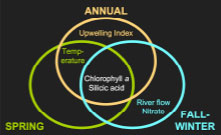Toxigenic Bloom Predictive Model, Monterey Bay: Background
Model Specifics
Blooms of the diatom genus Pseudo-nitzschia are a public health issue in California. Toxigenic species of Pseudo-nitzschia produce the neurotoxin domoic acid, which can build up in shellfish tissues. Although Pseudo-nitzschia blooms are recurring and recognized hazards, the factors driving bloom proliferation remain poorly understood and the development of robust forecasting tools is difficult.
Researchers from the University of California Santa Cruz and the California Department of Public Health have successfully developed predictive logistic models of toxigenic Pseudo-nitzschia blooms in Monterey Bay, California. Models were developed for both year-round and seasonal use. For all models, predictive power for “unknown” (future) bloom cases was demonstrated at ≥75%, out-preforming a chl a anomaly model, and performing comparably to, or better than, previously described statistical models for Pseudo-nitzschia blooms or toxicity.
These models are the first to have been developed from long-term (>1.5 yr) monitoring efforts, and the first to have been developed for bloom prediction of toxigenic Pseudo-nitzschia species. The descriptive capacity of these models places historical and recent observations into greater ecological context, which could help to resolve historical alternation between the implication of freshwater discharge and upwelling processes in bloom dynamics.
Source: Lane et al., 2009

This diagram shows the input variables for each of the three Monterey Bay predictive models - Spring (February 14- June 30), Fall-Winter (July 1 - February 13), and Annual. For model specifics, click here.

